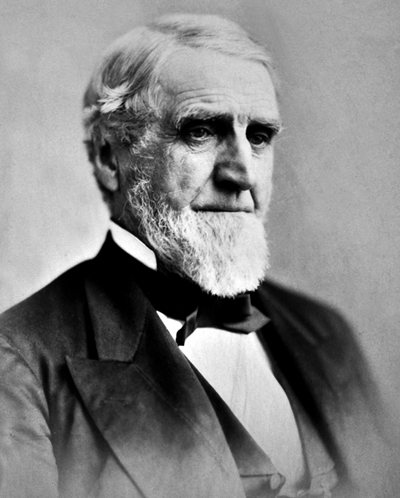Asa Packer featured in Spring Quarterly

SAYRE - The Spring issue of the Sayre Historical Society Quarterly highlights the life of Asa Packer, father of Robert Packer, whose industrial empire had a direct and long-lasting impact on the history of Sayre. Other stories in the latest issue of the local history magazine are the sale of Oak Grove Park in 1944, the obituary of former postmaster George M. Lull in 1901 and the railroad photographs of the late James F. Ward.
CAPTION: Asa Packer, father of Robert A. Packer, is the subject of a cover story in the Sayre Historical Society's Spring Quarterly. The photograph above was taken by photographer Frederick Gutekunst and is part of the historical society's Chemung Canal Trust Company Collection. (Sayre Historical Society)
The Quarterly is published four times a year and is mailed to historical society members as part of their membership benefits. Individual copies are available at Carl's News Stand in Sayre and the historical society museum located in the former Lehigh Valley Railroad Passenger Station in downtown Sayre. The museum will reopen for the season on Saturday, April 6 with a new exhibit "Working on the Railroad: Sayre and the Lehigh Valley Railroad."
Asa Packer was born in Mystic, Connecticut on December 29, 1805 and used his "receptive mind and habits of thought and observation" to amass one of the country's great fortunes. But the man who founded the Lehigh Valley Railroad and funded the famous Lehigh University had a humble start when he left his boyhood home and traveled west.
"He packed all his worldly possessions, consisting of a few simple articles of clothing, shouldered his humble pack, and set out afoot to make his way in a great world which was altogether unknown to him," said Hopkin Thomas, who chronicled Packer's life for the on-line Hopkin Thomas Project.
Packer learned the carpenter's trade and eventually secured work with the newly-opened Lehigh Canal.
"He drove in a primitive sled to Mauch Chunk, made a satisfactory engagement, and then returned home to close up his affairs in time for the opening of navigation. In the spring, he set out to engage in his new undertaking, walking to Tunkhannock, on the Susquehanna River, where he boarded a raft which took him to Berwick, whence he walked to Mauch Chunk," according to the Thomas account in the Quarterly.
Through his connections to the Lehigh Canal and the burgeoning coal trade, Packer became acquainted with Commodore Stockton who helped Packer develop the Lehigh Valley Railroad, according to the July 21, 1869 Tunkhannock Democrat.
In his later years, Packer started Lehigh University in South Bethlehem by donating land and money in 1865 and making additional donations ten years later.
Packer also served as an associate judge, was an elected member of the U.S. Congress and was even nominated during the National Democratic Convention for president and later governor. His local legacy includes his son Robert, whose home became Robert Packer Hospital, largely though the donation of the vacant home by Robert's sister, Mary, in 1885. Through the generosity of Mary Packer, the Church of the Redeemer and the former Coleman Memorial Parish House were built.
Asa Packer died at the age of 74 on May 7, 1879. One of the Lehigh's fast passenger trains carried the name of its founder and operated between the cities of Easton, Bethlehem, Allentown and Mauch Chunk.
Another story in the Quarterly recalls Oak Grove Park, a short-lived park located on S. Keystone Avenue. An October 19, 1944 article by George R. Loop recounts the site which operated from about 1906 to 1909. The popular recreation spot was located in the 300 block of South Keystone Avenue across from Chemung Street behind the current Family Dollar Store.
Loop describes the somewhat unusual location of Oak Grove Park in his article.
"The steep sides are covered with a fine growth of oak," he wrote. "The hole in the ground cannot be accounted for. It looks as though a huge meteorite had plunged from the heavens to find its resting place in the pool that exists at the bottom. It might have been created by glacial action during the ice age, as most of the ground in this section shows this effect. Draw upon your imagination for the solution of the mystery."
The article includes a rare photographic view of what is believed to be the entrance to the park from a postcard dated 1907.
A story on the late James Ward also includes photographs donated to the Valley Railroad Museum in 1994 and recently printed for the new exhibit at the Sayre Historical Society. Ward worked as a senior electrician for the railroad and later was employed as a test lab technician for IBM for many years. He was born on October 19, 1918, the son of James Lawrence Ward and Anna L. Hughes. He was a 1936 graduate of Sayre High School, a member of the Epiphany Church and enjoyed amateur radio, electronics, photography, fishing and watching baseball games, according to his obituary. He married the former Marilyn Jayne Vaughn in 1945.
A double page view of the former Robert Packer Hospital and a four-page section on the R. & E. Pattern & Foundry Corp. in Sayre is also included in the issue.
A 1959 photograph shows John Polinski playing accordion as part of a Sayre Recreation Talent Show. Polinski was also a member of a musical group called the Hi-Lo's, formerly known as the Eight-Teens. The photograph was donated to the historical society by Sandra Paluzzi.
The Sayre Historical Society is a member-supported, non-profit organization and a recipient of funding from the United Way and the Bradford County Tourism Promotion Agency.
